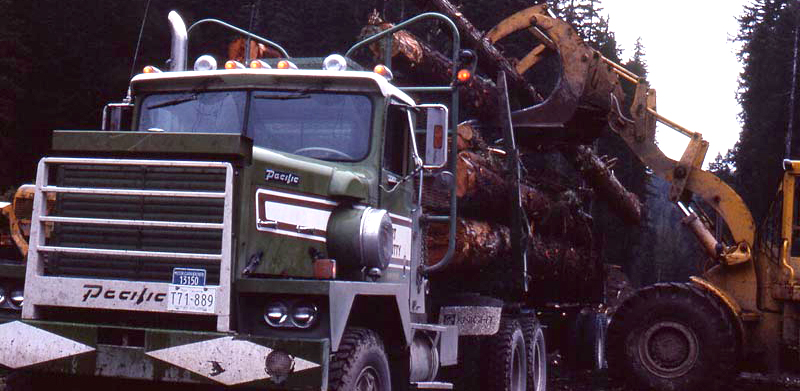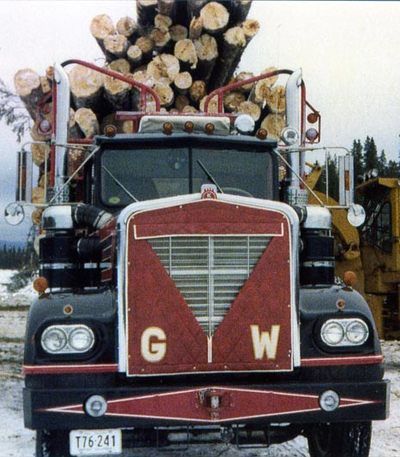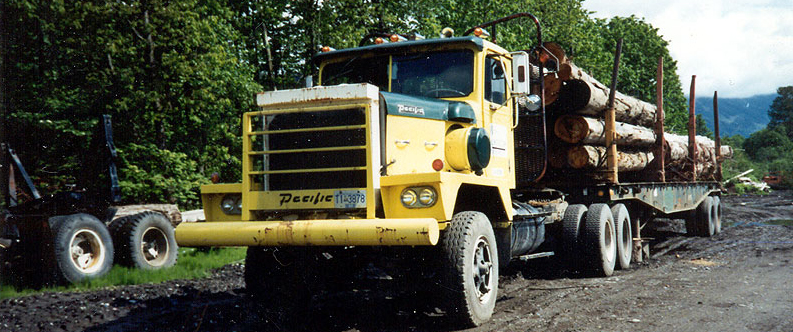|
British Columbia Logging License Plates |
||||||||||||||||||||||||||||||||||||||||||||||||||||||||||||||||||||||||||||||||||||||||||||||||||||||||||||||||||||||||||||||||||||||||||||||||||||||||||||||||||||||||||||||||||||||||||||||||||||||||||||||||||||||||||||||||||||||||||||||||||||||||||||||||||||||||||||||||||||||||||||||||||||||||||||||||||||||||||||||||||||||||||||||||||||||||||||||||||||||||||||||||||||||||||||||||||||||||||||||||||||||||||||||||||||||||||||||||||||||||||||||||||||||||||||||||||||||||||||||||||||||||||||||||||
Quick Links: |
Forestry
is one of the most important industries in British Columbia,
and as a result there have been a number of plates that have
been used by logging companies. |
The
forestry industry in British Columbia has also witnessed some
of the fiercest environmental protests (i.e. Clayquout Sound)
over harvesting (read: clear-cutting) practices, and it is
not without some irony that Logging license plates would not
display the "Beautiful British Columbia" until 1989
(25 years after the slogan was first introduced). |
*
* * * * |
Under the title of “New Letters on Car Plates”, the Victoria Times reported in 1938 that “three new letter classifications have been added to British Columbia`s motor licenses this year, segregating special classes of plates.” These included the letters “PW” (for vehicles belonging to the Public Works Department); “PN” (for vehicles belonging to Medical Doctors); and “PF” (for vehicles belonging to the Forestry Department). By far, the rarest of these new prefixes in terms of surviving examples has been the “PF” for the Forestry Department, with only one known example resurfacing in 2023 (in the collection of Neil Mattson). This is likely due to the plates only being used for one, or possibly two years. By 1940, the records maintained by the Motor Vehicle Branch (MVB) no longer make reference to the “PF” plate being used. |
1938 - 1939: "PF" |
|||||||||
1939 (????) |
|
||||||||
*
* * * *
|
Seasonal
plates are introduced in 1961 with quarterly expiry periods occurring
at the end of May, August and November of each year. From December 1st to the end of the registration year on February 28th, it is understood that logging trucks were issued standard "C" prefix plates. These
first two years of issue can be distinguished from later years
by the full use of the word "EXPIRES"
at the top of each plate: |
| 1961 - 1962 | ||||||||||
1961 (November Expiry) |
December 1st to February28th Quarter would would have been issued a "C" Prefix |
|
||||||||
December 1st to February28th Quarter would would have been issued a "C" Prefix |
||||||||||
The
general issuing sequence, to be used through 1976, would see
the first set issued from the No. T1; the second set from
T25-000; and the third set from T50-000. |
 |
*
* * * *
|
The period from the mid-1960s is characterised by the abbreviated "EXP." appearing at the top of the plate and by the fact that, despite the introduction of the "Beautiful" slogan on most plates types in 1964, this moniker would not be used on the Logging truck base (most likely due to space constraints): |
| 1963 - 1971 | ||||||||||
 |
1963 (November Expiry) |
December 1st to February 28th Quarter would would have been issued a "C" Prefix |
|
|||||||
 |
 |
 |
December 1st to February 28th Quarter would would have been issued a "C" Prefix |
|
||||||
 |
 |
 |
December 1st to February 28th Quarter would would have been issued a "C" Prefix |
|
||||||
 |
 |
 |
December 1st to February 28th Quarter would would have been issued a "C" Prefix |
|
||||||
 |
 |
 |
December 1st to February 28th Quarter would would have been issued a "C" Prefix |
|
||||||
 |
 |
December 1st to February 28th Quarter would would have been issued a "C" Prefix |
|
|||||||
 |
 |
 |
December 1st to February 28th Quarter would would have been issued a "C" Prefix |
|
||||||
 |
 |
December 1st to February 28th Quarter would would have been issued a "C" Prefix |
|
|||||||
 |
 |
December 1st to February 28th Quarter would would have been issued a "C" Prefix |
|
|||||||
 |
In this photo is a typical logging truck displaying a 1964 Motive Fuel plate (right) and a Commercial Truck plate (left) that would have been issued for use during the 4th quarter of the year (December 1st to February 28th). |
*
* * * *
|
The period of the mid-1970s is characterised by the removal of the date stamp that had appeared at the bottom right-hand corner of plates from 1960-71 (which was a rather redundant feature in hindsight given the expiry of the plates is clearly displayed at the top of the plates). |
Also
of note, the issuing sequence was altered in 1977 with the
first period possibly starting at T10-000; the second at T35-000;
and the third at T60-000: |
| 1972 - 1977 | |||||||||||
 |
 |
 |
December 1st to February 28th Quarter would would have been issued a Commercial plate |
|
|||||||
 |
 |
 |
December 1st to February 28th Quarter would would have been issued a Commercial plate |
|
|||||||
 |
 |
 |
December 1st to February 28th Quarter would would have been issued a Commercial plate |
|
|||||||
 |
 |
 |
December 1st to February 28th Quarter would would have been issued a Commercial plate |
|
|||||||
 |
 |
 |
December 1st to February 28th Quarter would would have been issued a Commercial plate |
|
|||||||
 |
 |
 |
December 1st to February 28th Quarter would would have been issued a Commercial plate |
|
|||||||
*
* * * *
|
Following the closure of the Oakalla production facility in the mid-1970s, the province began to contract out the manufacture of license plates and, as can be seen starting in 1978, new die types began to appear on the Logging base. |
| 1978 - 1979 - Quebec Dies (Acme Signalisation) | |||||||||||
 |
 |
 |
December 1st to February 28th Quarter would would have been issued a Commercial plate |
|
|||||||
 |
December 1st to February 28th Quarter would would have been issued a Commercial plate |
|
|||||||||

*
* * * *
|
In 1980, the period of each quarter was amended so that the licensing year commenced with the calendar year (whereas the registration year for most other vehicle types remained the end of February) and the quarters now finished at the end of March, May, September and December, with a "T" prefix plate introduced for the fourth quarter. The 1980 bases colour scheme of orange-on-white would also be rotated with the 1979 black-on-white scheme for a six year period (to 1985). |
| 1980 - 1983 | |||||||||||||
 |
 |
 |
 |
|
|||||||||
 |
|
It is assumed that these plates (No T76-241 at left and No. T79-412 at right) and others like them were issued as a bridge between the end of the 1979 licence year and the start of the 1980 licence year as the province was introducing staggered registration periods for most other forms of commercial vehicles. |
|
Apart from sporting the 1979 colour scheme, these particular plates expired on February 29, a date which had not previously been used on the Quarterly Logging Truck plates. In addition, the serial number does not correspond to any of the quarters used in 1980, but probably followed the end of the third quarter 'T' plates issued in 1979 (but it is not possible to confirm this as we are missing the issuing date for that year). |
 |
 |
 |
 |
|
 |
 |
 |
 |
|
 |
 |
 |
 |
|
*
* * * *
|
Given the die type used in 1984, it is thought that this year's plates were produced by High Signs of Edmonton, Alberta. Apart from the obvious design change with the introduction of a decal box at bottom centre, the expiry date underwent a minor modification with the replacement of dashes with dots (i.e. "30-9-83" was replaced with "30.09.84"): |
| 1984 | |||||||||||||
 |
 |
 |
|
||||||||||
*
* * * *
|
||||||||||||||||
There will probably never be a rational explanation to describe what happened with the 1985 plates (or subsequent issues as will be seen below). |
||||||||||||||||
As
has been written elsewhere on this site, when the Province
awarded the plate manufacturing contract to Astrographics
in the early 1980s, the company encountered a number of problems
trying to meet its obligations. Not least of the problems
was the failure of its main press. |
||||||||||||||||
It
is thought that that the plates shown below in the T2-8000
range were originally produced by Astrographics as genuine
Logging Truck plates. However, following the failure of their
press, alternate arrangements had to be taken to meet their
commitments to the Province. |
||||||||||||||||
This
would appear to include the re-use of plates originally issued
in 1984 which, rather fortuitously, contained decal boxes
thereby allowing for an ease of re-use. In addition, other
base types were pressed (pardon the pun) into duty by placing
a makeshift expiry date at the top of the plate. |
||||||||||||||||
|
||||||||||||||||
Accordingly,
there are effectively seen to be three different types of
1985 Logging Truck plates. |
||||||||||||||||
| When viewed up close, it is actually quite easy to decipher the different plate types that Astrographics was required to gang-press (pardon the pun) to meet the demand for Logging plates. |
||||||||||||||||
The
following image attempts to show how a "Trailer Floater"
plate was re-branded a Logging Truck plate. Run your mouse
over the image below to get a better view: |
||||||||||||||||
 Run your mouse over this image and BEHOLD! |
||||||||||||||||

*
* * * *
|
The problems encountered in 1985 were not unique and would be repeated for the next three years: |
| 1986 - 1988 (Black & Blue) | |||||||||||||
 |
 |
 |
|
||||||||||
 |
1986 (June Expiry - Black) |
 |
|||||||||||
 |
 |
 |
|
||||||||||
1987 (June Expiry - Black) |
 |
1987 (December Expiry - Black) |
|||||||||||
 |
 |
 |
 |
|
|||||||||
1988 (March Expiry - Black) |
1988 (June Expiry - Black) |
.jpg) |
1988 (December Expiry - Black) |
||||||||||

For
unknown reasons, the Astrographics had a hard time in 1987
accurately predicting the number of logging plates that would
be required in each of the quarters. As can partially be seen
on the example shown below, a September expiry was re-labeled
with a December 31st expiry. |
 |
This
following plate is one of my favourites. It is hard to see
in the above image, but if you look very closely you will
see the tops of letter sticking out ever so slightly above
the expiration date. Curious as to what it might say? Well,
run your mouse over it and the mystery will be revealed. |
 Run your mouse over this image and BEHOLD! |
Yes, despite the apparent abundance of September expiry plates
that resulted in the earlier example (shown just above) being
re-born as a December expiry, it would seem that September
soon was in short supply. An apparent over-supply of Repairman
bases was soon called upon to fill this shortage through the
application of a black strip (as part of the reflectorized
layer), to cover up the Repairman title. The plate was then
stamped with the standard "T" prefix for a Logging
plate. |
But
wait, it gets better, the following image shows that other
Logging plates were finally cannibalised for the purposes
of providing September expiry plates. |
||
|
||
Due
to the thickness of this particular black strip, it is not
possible to tell what month and year this plate came from,
but the blue strip underneath clearly identifies it as a Logging
plate. |
Finally,
and of particular amusement, the application of the makeshift
expiry date strip occasionally happened in a haphazard manner
as these identical plates received different coloured strips: |
||
|
||
|
*
* * * *
|
| Only by 1989, about a good five years after it had assumed the manufacturing of BC plates, was Astrographics able to begin issuing the Logging Truck base as it was intended - on the Flag Graphic base with decal renewal and the full "Beautiful British Columbia" displayed across the top of the plate. |
While
the plates shown below are hardly a representative sample,
it appears safe to assume that the quarterly registration
system of March; June; September and December expirations
has been retained. |
To
continue our hypothesizing, it is assumed that the series
was started at T0-0000 and has progressed sequentially since
this point. As can be seen from the plates issued between
1985 and 1988, it is probable that many of the available 100,000
combinations were used, however as date stamped plates, they
could easily be pulled off the roads to allow the series to
be re-commenced at zero. |
| 1989 - 2013 - "Beautiful" (finally!) | |||||||||||||||||||
 |
1990 |
 |
 |
|
|||||||||||||||
 |
1994 |
 |
1996 |
||||||||||||||||
1997 |
1998 |
1999 |
 |
||||||||||||||||
 |
2002 |
2003 |
2004 |
||||||||||||||||
2005 |
2006 |
2007 |
2008 |
||||||||||||||||
2009 |
2010 |
2011 |
2012 |
||||||||||||||||
2013 |
|||||||||||||||||||

While
it is recognised that Waldale probably would have overtaken
the manufacturing of these plates early in the new century,
it is not yet know at what point in the series this would
have occurred (stay tuned ...). |
Quick Links: |
|
© Copyright Christopher John
Garrish. All rights reserved.












.jpg)











.jpg)
.jpg)
.jpg)
.jpg)